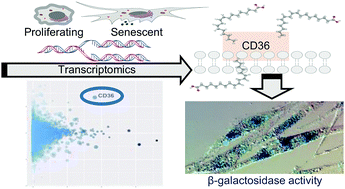当前位置:
X-MOL 学术
›
Mol. Omics
›
论文详情
Our official English website, www.x-mol.net, welcomes your feedback! (Note: you will need to create a separate account there.)
An evolutionary transcriptomics approach links CD36 to membrane remodeling in replicative senescence
Molecular Omics ( IF 2.9 ) Pub Date : 2018-06-20 , DOI: 10.1039/c8mo00099a Marie Saitou 1, 2, 3, 4, 5 , Darleny Y. Lizardo 2, 3, 4, 5, 6 , Recep Ozgur Taskent 1, 2, 3, 4, 5 , Alec Millner 2, 3, 4, 5, 6 , Omer Gokcumen 1, 2, 3, 4, 5 , Gunes Ekin Atilla-Gokcumen 2, 3, 4, 5, 6
Molecular Omics ( IF 2.9 ) Pub Date : 2018-06-20 , DOI: 10.1039/c8mo00099a Marie Saitou 1, 2, 3, 4, 5 , Darleny Y. Lizardo 2, 3, 4, 5, 6 , Recep Ozgur Taskent 1, 2, 3, 4, 5 , Alec Millner 2, 3, 4, 5, 6 , Omer Gokcumen 1, 2, 3, 4, 5 , Gunes Ekin Atilla-Gokcumen 2, 3, 4, 5, 6
Affiliation

|
Cellular senescence, the irreversible ceasing of cell division, has been associated with organismal aging, prevention of cancerogenesis, and developmental processes. As such, the evolutionary basis and biological features of cellular senescence remain a fascinating area of research. In this study, we conducted comparative RNAseq experiments to detect genes associated with replicative senescence in two different human fibroblast cell lines and at different time points. We identified 841 and 900 genes (core senescence-associated genes) that are significantly up- and downregulated in senescent cells, respectively, in both cell lines. Our functional enrichment analysis showed that downregulated core genes are primarily involved in cell cycle processes while upregulated core gene enrichment indicated various lipid-related processes. We further demonstrated that downregulated genes are significantly more conserved than upregulated genes. Using both transcriptomics and genetic variation data, we identified one of the upregulated, lipid metabolism genes, CD36, as an outlier. We found that overexpression of CD36 induces a senescence-like phenotype and, further, the media of CD36-overexpressing cells alone can induce a senescence-like phenotype in proliferating young cells. Moreover, we used a targeted lipidomics approach and showed that phosphatidylcholines accumulate during replicative senescence in these cells, suggesting that upregulation of CD36 could contribute to membrane remodeling during senescence. Overall, these results contribute to the understanding of evolution and biology of cellular senescence and identify several targets and questions for future studies.
中文翻译:

进化转录组学方法将CD36与复制性衰老中的膜重塑联系起来
细胞衰老是细胞分裂的不可逆转的停止,它与机体衰老,预防癌变和发育过程有关。因此,细胞衰老的进化基础和生物学特征仍然是一个有趣的研究领域。在这项研究中,我们进行了比较性的RNAseq实验,以检测与两种不同的人类成纤维细胞系以及在不同时间点复制衰老相关的基因。我们鉴定了两种细胞系中分别在衰老细胞中显着上调和下调的841个和900个基因(与衰老相关的核心基因)。我们的功能富集分析表明,下调的核心基因主要参与细胞周期过程,而上调的核心基因富集表明各种脂质相关过程。我们进一步证明,下调的基因比上调的基因保守得多。利用转录组学和遗传变异数据,我们确定了一种上调的脂质代谢基因,CD36,作为异常值。我们发现,CD36的过表达诱导衰老样表型,此外,单独CD36过度表达的细胞可以在增殖的年轻细胞中诱导衰老样表型。此外,我们使用了靶向脂质组学方法,并表明磷脂酰胆碱在这些细胞的复制衰老过程中积累,表明CD36的上调可能有助于衰老过程中的膜重塑。总的来说,这些结果有助于理解细胞衰老的进化和生物学,并确定一些目标和需要进一步研究的问题。
更新日期:2018-12-01
中文翻译:

进化转录组学方法将CD36与复制性衰老中的膜重塑联系起来
细胞衰老是细胞分裂的不可逆转的停止,它与机体衰老,预防癌变和发育过程有关。因此,细胞衰老的进化基础和生物学特征仍然是一个有趣的研究领域。在这项研究中,我们进行了比较性的RNAseq实验,以检测与两种不同的人类成纤维细胞系以及在不同时间点复制衰老相关的基因。我们鉴定了两种细胞系中分别在衰老细胞中显着上调和下调的841个和900个基因(与衰老相关的核心基因)。我们的功能富集分析表明,下调的核心基因主要参与细胞周期过程,而上调的核心基因富集表明各种脂质相关过程。我们进一步证明,下调的基因比上调的基因保守得多。利用转录组学和遗传变异数据,我们确定了一种上调的脂质代谢基因,CD36,作为异常值。我们发现,CD36的过表达诱导衰老样表型,此外,单独CD36过度表达的细胞可以在增殖的年轻细胞中诱导衰老样表型。此外,我们使用了靶向脂质组学方法,并表明磷脂酰胆碱在这些细胞的复制衰老过程中积累,表明CD36的上调可能有助于衰老过程中的膜重塑。总的来说,这些结果有助于理解细胞衰老的进化和生物学,并确定一些目标和需要进一步研究的问题。



























 京公网安备 11010802027423号
京公网安备 11010802027423号